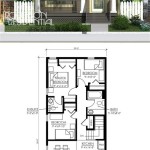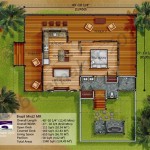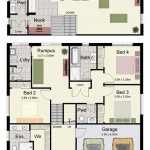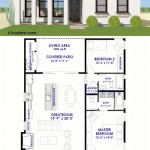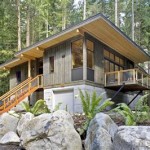Modern House Plans Without Garage: Maximizing Space and Styles
The increasing desire for compact living, sustainable design, and cost-effectiveness has led to a surge in the popularity of modern house plans without a garage. This design choice is particularly appealing in urban environments where parking is limited or homeowners prioritize outdoor living spaces and interior square footage over vehicle storage. Embracing this architectural approach necessitates careful planning and creative utilization of available space while incorporating contemporary design elements.
Modern house plans without a garage are not simply about omitting a space for vehicles. They represent a conscious decision to prioritize other aspects of a home's functionality and aesthetics. This can translate into larger living areas, expansive gardens, dedicated home offices, or even accessory dwelling units (ADUs). The absence of a garage often encourages innovative storage solutions and a more streamlined relationship with the outdoor environment.
Rethinking Space Allocation: Prioritizing Living Areas
One of the key advantages of forgoing a garage is the opportunity to reallocate that space to enhance living areas. The typical two-car garage occupies a substantial footprint, often ranging from 400 to 600 square feet. By eliminating this structure, architects and homeowners can reinvest that square footage into creating more spacious and functional interiors.
This reclaimed space can be used to expand the kitchen, creating a larger island, a walk-in pantry, or a dedicated dining area. Living rooms can be designed with more comfortable seating arrangements and larger windows, fostering a brighter and more inviting atmosphere. Home offices, increasingly important in the modern era, can be integrated more seamlessly into the floor plan, providing a dedicated workspace without sacrificing other living areas.
Furthermore, the absence of a garage allows for more flexible floor plan configurations. Open-concept designs can be implemented more effectively, creating a seamless flow between different living spaces. This promotes a sense of spaciousness and encourages social interaction within the home. Consider the potential for a dedicated mudroom or entryway with ample storage for coats, shoes, and other outdoor gear – a practical alternative to a garage entrance.
Careful consideration should be given to the orientation of the house on the lot. With the garage removed, opportunities arise for optimizing natural light and ventilation. Larger windows and strategically placed skylights can brighten interior spaces, reducing the need for artificial lighting during the day. The orientation of the home can also be optimized to capture prevailing breezes, promoting natural ventilation and reducing reliance on air conditioning.
Embracing Sustainable Design Principles
Modern house plans without a garage often align with sustainable design principles. By reducing the overall size of the building footprint, these plans can contribute to lower construction costs and reduced environmental impact. Smaller homes generally require less energy for heating and cooling, leading to lower utility bills and a smaller carbon footprint.
The absence of a garage can also encourage the use of more sustainable building materials. With the focus shifted towards interior living spaces, homeowners may be more inclined to invest in high-quality, eco-friendly materials such as reclaimed wood, bamboo flooring, and recycled content insulation. These materials contribute to a healthier indoor environment and reduce the demand for virgin resources.
Furthermore, the space saved by omitting a garage can be utilized for incorporating green features such as rainwater harvesting systems, solar panels, and vegetable gardens. Rainwater harvesting can be used for irrigation, reducing reliance on municipal water supplies. Solar panels can generate renewable energy, reducing dependence on fossil fuels. And vegetable gardens can provide fresh, locally sourced produce, promoting sustainable living and reducing food miles.
Design choices that promote energy efficiency are also crucial. Features such as energy-efficient windows and doors, well-insulated walls and ceilings, and high-efficiency appliances can significantly reduce energy consumption. Proper insulation is particularly important in maintaining comfortable indoor temperatures and minimizing energy waste. Energy-efficient windows and doors can prevent heat loss in the winter and heat gain in the summer.
Landscaping plays a vital role in sustainable design. Planting trees and shrubs around the home can provide shade, reducing the need for air conditioning. Native plants require less water and maintenance than non-native species, promoting biodiversity and reducing the environmental impact of landscaping. Permeable paving materials can be used for driveways and walkways, allowing rainwater to infiltrate the ground and reduce runoff.
Maximizing Outdoor Living and Storage Solutions
With the garage space repurposed, modern house plans often prioritize outdoor living areas. Decks, patios, and landscaped gardens become extensions of the interior living space, providing opportunities for relaxation, entertainment, and connection with nature. These outdoor areas can be designed to complement the overall aesthetic of the home, creating a cohesive and inviting environment.
Outdoor kitchens are becoming increasingly popular, allowing homeowners to prepare meals and entertain guests outdoors. These kitchens can be equipped with grills, countertops, sinks, and even refrigerators, creating a fully functional outdoor cooking space. Comfortable outdoor seating areas, such as lounge chairs and dining tables, encourage relaxation and social interaction.
Strategic landscaping can enhance the privacy and aesthetics of outdoor living areas. Trees, shrubs, and hedges can be used to create visual barriers, providing privacy from neighbors and creating a sense of seclusion. Water features, such as fountains and ponds, can add a calming and relaxing element to the outdoor environment.
Efficient storage solutions are essential in homes without garages. Built-in cabinetry, pull-out shelves, and vertical storage systems can maximize space and keep belongings organized. Closet organizers can help to optimize storage space in bedrooms and hallways. Attics and basements can also be utilized for storage, provided they are properly insulated and ventilated.
Consider the possibility of incorporating outdoor storage sheds or structures to compensate for the absence of a garage. These sheds can be used to store gardening tools, bicycles, and other outdoor equipment. They can be designed to blend seamlessly with the overall aesthetic of the home, adding to the visual appeal of the property.
Off-site storage solutions, such as renting a storage unit, can also be a viable option for homeowners who have limited storage space. This can be particularly useful for storing seasonal items or items that are not frequently used. However, off-site storage can be less convenient than having storage space within the home, so careful consideration should be given to the pros and cons.
In conclusion, modern house plans without a garage offer a compelling alternative to traditional home designs. By prioritizing living areas, embracing sustainable design principles, and maximizing outdoor living and storage solutions, these plans can create functional, stylish, and environmentally friendly homes. This approach represents a shift towards a more conscious and deliberate way of living, reflecting a growing desire for compact living, sustainability, and a deeper connection with the surrounding environment.

Split Level House Plans Without Garage Drummondhouseplans Com

Rectangle House Plan With 3 Bedrooms No Hallway To Maximize Space 10
Split Level House Plans Without Garage Drummondhouseplans Com

Modern House Design How To Achieve Openness In

Split Level House Plans Without Garage Drummondhouseplans Com

Split Level House Plans Without Garage Drummondhouseplans Com

Modern House Plans Floor Designs The Designers

50 Images Of 15 Two Y Modern Houses With Floor Plans And Estimated Cost

Low Budget Modern 3 Bedroom House Design Designs And Plans Pdf Books

Discover The Best 3bhk House Designs In 1000 Sq Ft
Related Posts


